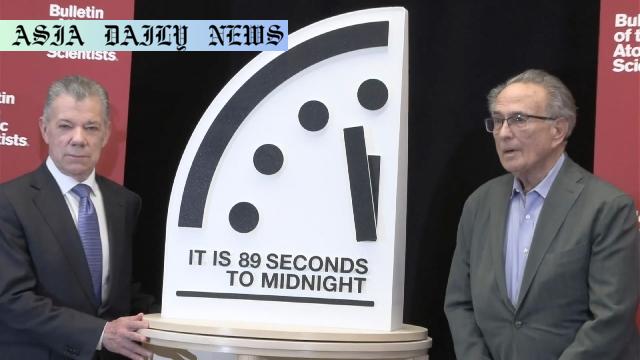Doomsday Clock: The Bulletin of the Atomic Scientists moves the clock closer, citing nuclear risks, climate change, and global threats.

The Significance of the Doomsday Clock
The Doomsday Clock serves as a symbolic representation of humanity’s proximity to global catastrophe, monitored and adjusted by The Bulletin of the Atomic Scientists. Established in 1947, the clock embodies the severity of international threats, including nuclear tensions, climate change, and now, emerging factors like artificial intelligence. This year’s setting at 89 seconds to midnight—the closest it has ever been—signals the urgency of global intervention.
Why Was the Clock Moved Forward?
Several factors prompted the adjustment of the clock in 2024. Chief among these is the increasing risk of nuclear weapons use, exacerbated by geopolitical instability and the lack of effective disarmament efforts. Additionally, the world continues to grapple with environmental challenges. Though 2024 was the hottest year on record, insufficient global measures have been enacted to combat the long-term effects of climate change.
The Role of Emerging Technologies and Global Health
Another pressing concern highlighted is the growing use of artificial intelligence in military operations. AI weaponization not only raises ethical dilemmas but also amplifies the potential for unintended escalations in conflict scenarios. The proliferation of infectious diseases in a post-pandemic world further adds to the complexity of global challenges, complicating the picture of humanity’s preparedness against future crises.
The Call for Concerted Global Actions
Prominent figures, such as Nobel Peace Prize laureate Juan Manuel Santos, have emphasized the dire need for international cooperation. Santos criticized unilateral actions like the United States’ intention to withdraw from the Paris Agreement, as such decisions undermine collective climate action. His remarks underscore the necessity for nations to unify against shared threats rather than focusing inwardly.
The Historical Context of the Clock
The Doomsday Clock has evolved over time, reflecting a spectrum of global challenges. Originally focused on nuclear weapons during the Cold War era, its scope has expanded to incorporate environmental issues and technological advancements. The clock’s movement not only tracks the severity of risks but also serves as a barometer for the international community’s responsiveness to mitigating them.
What Lies Ahead: Potential Solutions
To push the clock back from this precarious juncture, decisive action is imperative. Governments need to renew commitments to arms control treaties and climate agreements. Scientific communities must continue advocating for data-driven solutions, while international organizations work tirelessly to bridge divides. Public awareness campaigns are also crucial in placing pressure on policymakers to prioritize humanity’s future.
Conclusion
The Doomsday Clock’s ominous setting at 89 seconds to midnight is a stark reminder of the challenges humanity faces. From escalating nuclear risks and climate inaction to emerging threats like AI militarization and infectious diseases, we are at a critical juncture. However, through unity and bold action, there remains hope for reversing time on the clock and securing a sustainable future for all.
Commentary
Interpreting the Doomsday Clock’s Signal
The Doomsday Clock is not just a symbol—it is a wake-up call. Its latest adjustment to 89 seconds to midnight highlights the dire challenges we face as a global community. Nuclear risks, climate degradation, and technological militarization are no longer distant threats; they are urgent realities. This symbolic ticking clock urges us to take collective action before it’s too late.
The Importance of Collaboration
One of the most pressing lessons from the Doomsday Clock’s adjustment is the necessity of global unity. Challenges such as climate change and nuclear proliferation do not recognize borders, making international cooperation indispensable. Political discord, such as the United States’ wavering commitment to climate accords, only worsens the situation. Now more than ever, partnerships and diplomatic solutions need to take center stage.
Hope Amid Uncertainty
While the clock’s setting is alarming, it’s also a clarion call for hope and action. History has shown humanity’s capacity for resilience and innovation, whether through diplomatic breakthroughs or scientific advancements. By working together, we can still reverse this trajectory. The ticking of the Doomsday Clock is not a death knell—it is a challenge for us to change the course, one decision at a time.


